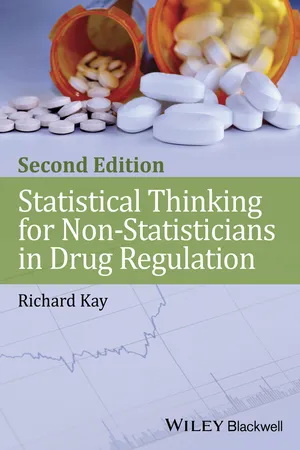
- English
- ePUB (mobile friendly)
- Available on iOS & Android
Statistical Thinking for Non-Statisticians in Drug Regulation
About this book
Statistical Thinking for Non-Statisticians in Drug Regulation, Second Edition, is a need-to-know guide to understanding statistical methodology, statistical data and results within drug development and clinical trials.
It provides non-statisticians working in the pharmaceutical and medical device industries with an accessible introduction to the knowledge they need when working with statistical information and communicating with statisticians. It covers the statistical aspects of design, conduct, analysis and presentation of data from clinical trials in drug regulation and improves the ability to read, understand and critically appraise statistical methodology in papers and reports. As such, it is directly concerned with the day-to-day practice and the regulatory requirements of drug development and clinical trials.
Fully conversant with current regulatory requirements, this second edition includes five new chapters covering Bayesian statistics, adaptive designs, observational studies, methods for safety analysis and monitoring and statistics for diagnosis.
Authored by a respected lecturer and consultant to the pharmaceutical industry, Statistical Thinking for Non-Statisticians in Drug Regulation is an ideal guide for physicians, clinical research scientists, managers and associates, data managers, medical writers, regulatory personnel and for all non-statisticians working and learning within the pharmaceutical industry.
Frequently asked questions
- Essential is ideal for learners and professionals who enjoy exploring a wide range of subjects. Access the Essential Library with 800,000+ trusted titles and best-sellers across business, personal growth, and the humanities. Includes unlimited reading time and Standard Read Aloud voice.
- Complete: Perfect for advanced learners and researchers needing full, unrestricted access. Unlock 1.4M+ books across hundreds of subjects, including academic and specialized titles. The Complete Plan also includes advanced features like Premium Read Aloud and Research Assistant.
Please note we cannot support devices running on iOS 13 and Android 7 or earlier. Learn more about using the app.
Information
Chapter 1
Basic ideas in clinical trial design
1.1 Historical perspective
Example 1.1 The Salk Polio Vaccine trial
1.2 Control groups
ICH E10 (2001): ‘Note for Guidance on Choice of Control Group in Clinical Trials'
- Active versus placebo
- Active A versus active B (vs. active C)
- Placebo versus dose level 1 versus dose level 2 versus dose level 3 (dose finding)
- Active A + active B versus active A + placebo (add-on)
1.3 Placebos and blinding
ICH E9 (1998): ‘Note for Guidance on Statistical Principles for Clinical Trials'
Table of contents
- Cover
- Title page
- Copyright page
- Preface to the second edition
- Preface to the first edition
- Abbreviations
- Chapter 1: Basic ideas in clinical trial design
- Chapter 2: Sampling and inferential statistics
- Chapter 3: Confidence intervals and p-values
- Chapter 4: Tests for simple treatment comparisons
- Chapter 5: Adjusting the analysis
- Chapter 6: Regression and analysis of covariance
- Chapter 7: Intention-to-treat and analysis sets
- Chapter 8: Power and sample size
- Chapter 9: Statistical significance and clinical importance
- Chapter 10: Multiple testing
- Chapter 11: Non-parametric and related methods
- Chapter 12: Equivalence and non-inferiority
- Chapter 13: The analysis of survival data
- Chapter 14: Interim analysis and data monitoring committees
- Chapter 15: Bayesian statistics
- Chapter 16: Adaptive designs
- Chapter 17: Observational studies
- Chapter 18: Meta-analysis
- Chapter 19: Methods for the safety analysis and safety monitoring
- Chapter 20: Diagnosis
- Chapter 21: The role of statistics and statisticians
- References
- Index
- End User License Agreement